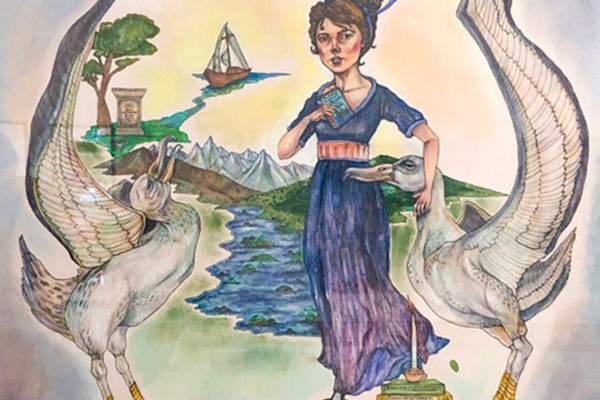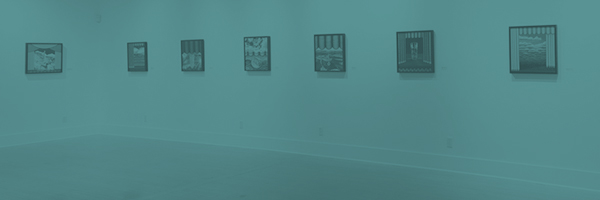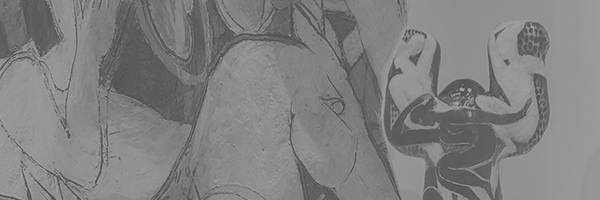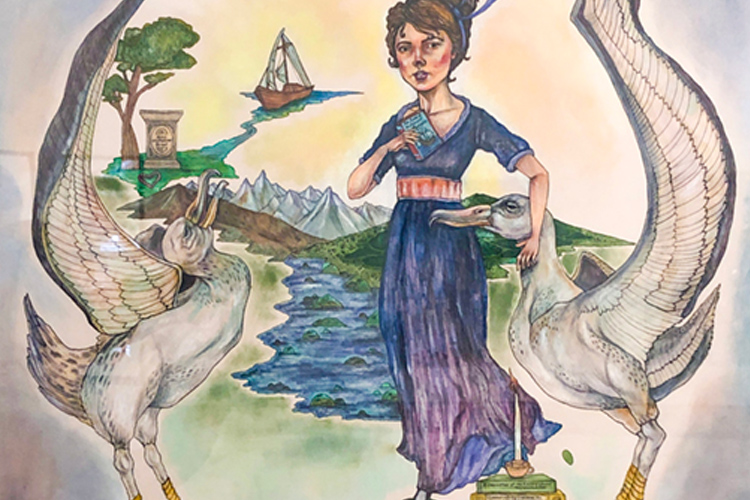
Exhibit by Courtney Blazon
I created this series of stream-of-consciousness narrative drawings on the bicentennial of the April 1815th eruption of the Mount Tambora volcano on the island of Sumbawa in Indonesia. It is considered the 3rd largest volcanic eruption in recorded history. The eruption caused total devastation to the surrounding area with global repercussions reaching far beyond. Volcanic gasses caused a worldwide aerosol cloud that clogged up the sky. The following year, climate anomalies were recorded around the world.
Emerson Lobby
September 10 – November 26, 2021
Artist Statement
The volcanic winter and subsequent effects on European and North American crops caused 1816 to be known as the “Year Without A Summer.” This eruption catalyzed a whole host of events that spanned from the horrific and tragic, to the literary and cultural. A long list of the amazing things that can be directly linked to the Volcano Tambora eruption include the birth of modern climate science, the birth of modern meteorology, the opening of the Northwest Passage, the advent of the Chinese opium trade, the birth of gothic horror, and American westward expansion.
These drawings link together the far-reaching effects of the eruption and demonstrate the global impact of this singular event, as well as making a connection to our current manmade climate state. My fantastical works form a chronicle that bridges the catastrophe with the inspired global impact that followed. The series is a set of interrelated “surrealistic, symbolist, and fantastical” drawings that touch on the resulting worldwide crop failures, disease outbreaks, scientific discoveries, and the birth of literary Gothic Horror at Villa Diodati in Switzerland where Mary Shelley wrote Frankenstein.
I depict “the dead and living” coming together to narrate a story with far-reaching cultural and social consequences. I populate the drawings with historical figures influenced by the effects of the eruption. Painter J.M.W. Turner’s luminous paintings may have been inspired by bizarre and eerie sunsets caused by the ash in the atmosphere. Founding father Benjamin Franklin was an early proponent of the idea that a volcanic eruption could affect global weather. Thomas Jefferson advocated for the importance of accurate meteorological recordings. The Royal families of Europe whose response to the cataclysmic event was criticized for being disconnected and callous.
Scholar turned farmer turned poet, Li Yuyang, resurrected the ancient Chinese poetry form called the “Poetry of the Seven Sorrows” as a response to watching his people in the Yunnan province starve and suffer disease as a result of the volcanic gases. I also explore investigations into the further reaching aspects of the eruption including Manifest Destiny (in the form of the Donner Party), and a satirical look at our present climate state as depicted through the seven deadly sins.
Artist Bio
Courtney Blazon is an artist and illustrator residing in Missoula, MT. She earned a BFA in Illustration from Parsons School of Design. In Montana, her works have been shown at the Missoula Art Museum, Holter Museum of Art, and Paris Gibson Square Museum of Art, and most recently at Northcutt Steele Gallery in Billings. Nationally, Courtney’s distinctive art has been shown in Seattle, Portland, New York, Philadelphia, Baton Rouge, San Francisco, and Jackson, Wyoming.
Her work has been featured in New American Paintings (Western Edition), Studio Visit Magazine, and juxtapoz.com. Courtney is the co-organizer of the popular Montana MADE Fairs, a series of art and craft fairs started in 2007. She is a past recipient of the Montana Arts Council Artists Innovation Award, and is represented by Radius Gallery in Missoula, MT.
About the Works
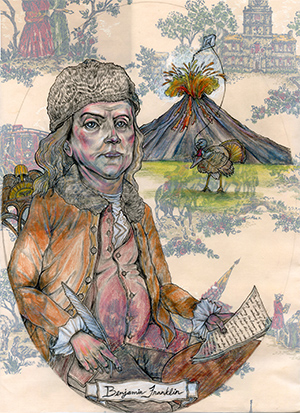
1. Meteorological Imaginations and Conjectures
Digital Print of Original Pen and Pencil Drawing – 18″ x 24″
Name: Benjamin Franklin
Born: 1706-Jan-17
Died: 1790-Apr-17, age 84
BIOGRAPHY
Benjamin Franklin, a Founding Father of the United States, was renowned as an author, diplomat, politician, and scientist, and for his many inventions, including the lightning rod, bi-focal lenses, and the Franklin stove, a more efficient metal-lined fireplace.
CONNECTIONS
A keen observer of the natural world, Franklin was the first to make the connection between volcanic activity and climate change. In his paper, “Meteorological Imaginations and Conjectures”, presented to the Manchester Philosophical Society in December 1784, he postulated that the terrible weather, crop failures, and general misery in Europe in 1784 were the result of the eruption of the Icelandic volcano Laki in June 1783.
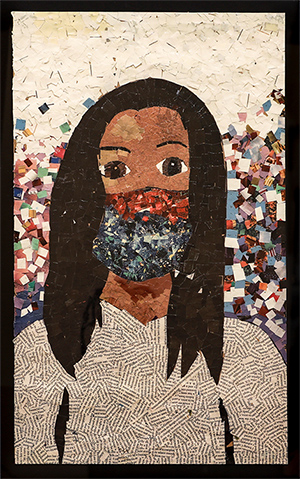
2. Le Diable Boiteux
Pen, Marker and Pastel on Paper – 22” x 30”
George Gordon, Lord Byron, is considered to be one of the greatest British poets, and remains widely read today. This portrait depicts Byron as a young man, framed by a stylized version of the family coat of arms: two rearing foals, beneath a pair of mermaids.
In 1798, at the age of 10, Byron inherited the abbey, along with his title, upon the death of his mad great-uncle William, who had let the abbey fall into ruin. The mermaids are relaxing on an arch of the decaying Newstead Abbey, ancestral home of the Byrons, in ottinghamshire, England. Crede Byron [Trust Byron], the family motto, is entwined around the foals’ tails, which are further adorned with cameos of Byron’s parents.
Byron had a marked fondness for animals (Newstead Abbey boasted a tame wolf and a tame bear); but wherever he lived, his household always included a variety of different creatures.
Byron was born with a deformity of his right leg called a club foot, and wore a special boot in an effort to correct it. Byron’s disability did not prevent his participation in athletics: he boxed and played cricket at college, and swam throughout his adult life.
Byron’s brilliant poems (an excerpt from On the Death of a Young Lady is shown here) brought him celebrity and adulation at an early age.
His wife called it “Byromania”. Notorious for his several love affairs (with men as well as women), and for his enormous gambling debts, Byron fell into disfavor. In April of 1816, he fled to Europe, never to return to England.
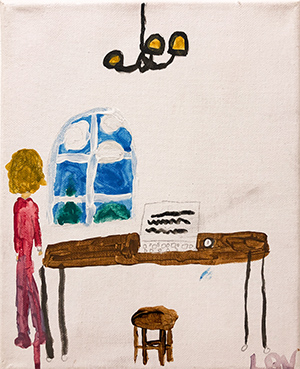
3. Mad, Bad and Dangerous to Know
Pen, Marker and Pastel on Paper – 22” x 30”
After spending the summer of 1816 in Switzerland, Byron moved to Italy, where he lived for the next seven years, in Venice, Ravenna, Pisa, and finally Genoa. During this period, he wrote several major poems, including his masterpiece, Don Juan, a long meander full of humor and wicked satire, published serially from 1819 till his death. Byron’s works wielded enormous influence on the romantic movement, and on the development of European poetry.
While living in Italy, Byron assembled a huge menagerie of dogs, monkeys, peacocks, guinea fowl, and a falcon. After the death of Shelley in 1822, Byron became involved with the Greek Revolution, a war of independence waged by Greek insurgents against the Ottoman Empire. He is shown here in the garb of a Greek soldier. Behind him, flying the Greek flag, is the ruin of the ancient Temple of Poseidon at Cape Sounion, where Byron’s name is carved on a column. In the distance, the sinking caves of Matala, in Crete, serve as a warning of the potential conseguences of present-day global warming.
An excerpt from Don Juan:
Let us have wine and women
Mirth and laughter;
Sermons and soda water,
The day after.
After a parade of lovers, Byron met the Countess Teresa Guiccioli in Italy, in 1818. She would become the love of his life.
From She Walks in Beauty:
She walks in beauty,
like the night
Of cloudless climes
and starry skies;
And all that’s best
of dark and bright
Meet in her aspect
and her eyes.
Throughout Europe, there was great sympathy for the Greek struggle for independence, primarily because of the strong
influence that ancient Greece exerted on European cultural history. Byron lent his name, prestige and wealth to the cause, and was among several aristocrats to take up arms in support.
Byron’s death in 1824 from fever, early in the war, served to increase European support for Greek independence, leading Western powers to intervene. Although his body was brought back to England and buried at Newstead Abbey, Byron remains a hero in Greece to this day.
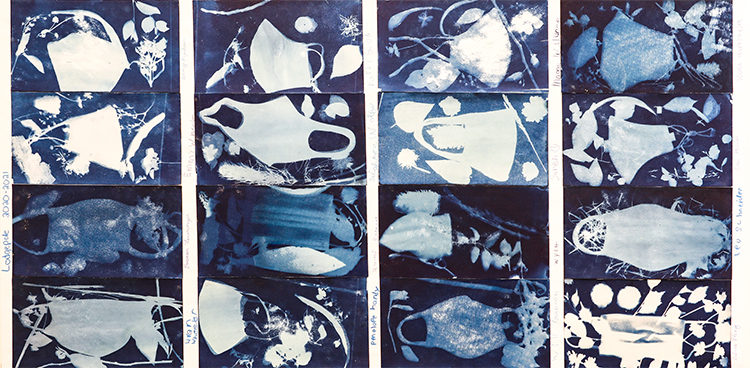
4. Polly Dolly, Poor Polidori
Pen, Marker and Pastel on Paper – 22” x 30”
Polly Dolly Poor Polidori
Doctor John Polidori, an Englishman of Italian descent, was both an author and a physician. Polidori was schooled by Benedictine monks at Ambleforth Abbey, in Yorkshire, England. He received his degree as a Doctor of Medicine from Edinburgh University in 1815 at age 19, but was too young to be licensed to practice.
Adrift in London, Polidori was hired by Lord Byron to serve as his personal physician on Byron’s trip to Europe in 1816. A publisher offered, and Polidori accepted, 500 pounds sterling (around $50,000 in 2016 dollars) to keep a diary of his travels with Lord Byron.
Polidori’s contribution to the ghost stories told at Villa Diodati would become The Vampyre, often cited as the forefather of modern vampire fiction.
At Villa Diodati in Switzerland, Polidori was infatuated with Mary Godwin, on one occasion severely spraining his ankle in his enthusiasm to welcome her there.
The Vampyre was inspired both by Glenarvon, an autobiographical tale by Lady Caroline Lamb about her love affair with Lord Byron, and by Polidori’s bitter personal experience with the self-centered Byron’s sense of entitlement and propensity for bullying.
In a final cruel blow from Fate, an unscrupulous journalist published The Vampyre as a work by Byron, rather than by Polidori. It proved a huge success, and it took exceptional efforts by Polidori to restore his name to the work, only to have his association with such a notorious document thwart his plans to pursue theological studies.
In London in August 1821, constantly overshadowed by Byron, and weighed down by depression and gambling debts, the 25-year old Polidori committed suicide by drinking a vial of Prussic acid (cyanide), finally lifting the dark clouds from above his head.
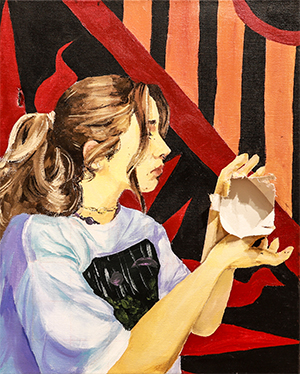
5. Cor Cordium
Pen, Marker and Pastel on Paper – 22” x 30”
Percy Blythe Shelley, considered one of the finest poets in the English language, is perhaps best remembered for his shorter poems, such as
To a Skylark (“Hail to thee, blithe Spirit! Bird thou never wert.”), and Ozymandias (“Look on my works, ye Mighty, and despair!”).
Born in 1792 in West Sussex, England, Shelley was a fervent idealist, and a strong advocate for non-violence and social justice, as well as vegetarianism. His radicalism and outspoken beliefs made him an inspiration to several generations of poets and intellectuals.
In 1814, Shelley abandoned his pregnant wife, Harriet, and ran away to Switzerland with 16-year-old Mary Godwin. In the tumultuous summer of 1816, on a second trip to Switzerland, Percy and Mary (along with Claire Clairmont) rented accommodations near Lord Byron, on Lake Geneva. The close-knit group would often socialize together.
After Harriet’s suicide, in December 1816, Shelley married Mary Godwin. In 1818, forced to flee England to escape creditors, they moved to Italy, living in various cities while enjoying considerable intellectual and political freedom. It was there that Shelley completed his masterpiece, Prometheus Unbound, as well as his Elegy on the Death of Keats.
Mont Blanc, the highest peak in the Alps, was the subject of Shelley’s 1816 poem of the same name. Written after an outing with Mary Godwin and Claire Claitmont, the poem contrasts the power of nature with the power of human thought. Shelley’s fascination with volcanoes is evident from this report after his ascent Mount Vesuvius, south of Naples, Italy: “Vesuvius is, after the Glaciers, the most impressive exhibition of the energies of nature I ever saw. On the summit stands a cone from which roll forth columns of black bituminous vapor, and fountains of red and radiant liquid fire.”
In July 1822, at the age of 29, Shelly was sailing in the Gulf of La Spezia (also called the Bay of Poets) when a sudden storm swamped his boat, the Don Juan, and it sank. Shelley and two shipmates drowned. His on-board library was lost. Shelley’s body washed up on shore days later; his remains were cremated there. His ashes are interred in Rome, where his tombstone bears a Latin inscription, and a quote from Shakespeare’s The Tempest:
“Cor Cordium”
“Nothing of him that doth fade,
But doth suffer a sea-change
Into something rich and strange.”
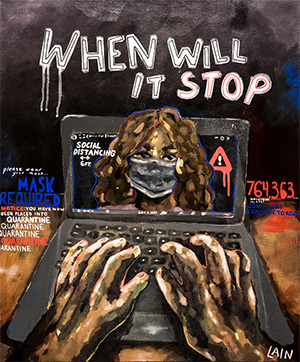
6. The Harmless Albatross
Pen, Marker and Pastel on Paper – 22” x 30”
She was born Mary Wollstonecraft Godwin, the child of two eminent political philosophers. Her mother, Mary Wollstonecraft, author of the feminist manifesto, A Vindication of the Rights of Woman, died shortly after Mary’s birth, leaving Mary in the care of her father William Godwin, renowned for his Enquiry Concerning Political Justice, as well as for The Adventures of Caleb Williams, the first British detective novel.
Her father described Mary as “bold, imperious, and active of mind”, and provided her with an advanced (if somewhat unusual) education covering a wide range of subjects. Mary learned of her mother’s life from the biography her father wrote, and cherished the memory of the mother she never knew.
Hiding behind the sofa as a child, Mary Shelley would listen to Samuel Taylor Coleridge, a frequent visitor to her father’s home, recite his long poem, The Rime of the Ancient Mariner. Here’s an excerpt:
Water, water, everywhere,
And all the boards did shrink;
Water, water, everywhere,
Nor any drop to drink.
The major themes of this epic: hubris and nemesis, humility and redemption through fortitude, would exert a strong influence on Mary throughout her tumultuous life.
Mary met Percy Shelley in November 1812, when he was 20 and she only 15. After a rather surreptitious courtship, passions flared, and in July 1814, they ran off to France, never to part (like a pair of albatrosses). Nor did the creativity sparked by their union go unnoticed. The popularity and influence of their literary efforts continue to the present day.
In an autobiographical thumbnail of her youth, Mary Shelley wrote: “It is not singular that, as the daughter of two persons of distinguished literary celebrity, my favourite pastime was to write stories. Still, castles in the air – indulging in waking dreams – were at once more fantastic and agreeable than my writings. I lived principally in the country as a girl, and passed a considerable time in Dundee, Scotland, on the shores of the River Tay, where I could commune with the creatures of my fancy. It was beneath the trees of the grounds belonging to our house, or on the bleak sides of the woodless mountains near, that my true compositions, the airy flights of my imagination, were born and fostered, and I could people the hours with creations far more interesting to me than my own sensations.”
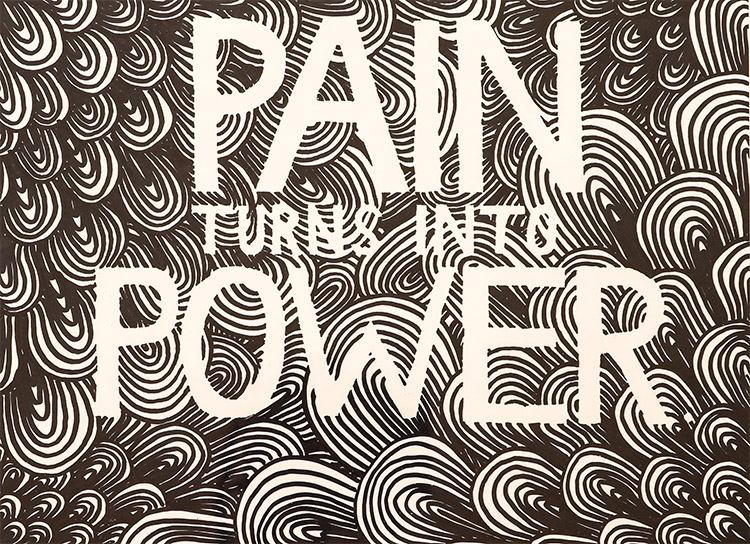
7. The Cup of Life was Poisoned
Pen, Marker and Pastel on Paper – 22” x 30”
Mary Shelley’s time with Percy Shelly was intense but short, a mere eight years from their elopement in 1814 (when she was 16) until his drowning in 1822 (when she was 24). In this interval, she also survived a life-threatening miscarriage, and buried her first three children: Clara (lived 1 month), William (lived 3 ½ years), and Clara Everina (lived 12 months).
Samuel Taylor Coleridge’s epic poem, The Rime of the Ancient Mariner, had a profound effect on Mary. The Rime tells the tale of a mariner who brings a curse upon himself and his crew by shooting an albatross that had saved their ship from an icy grave. As penance, and as a reminder of the curse, he is forced to wear the albatross around his neck as he pursues redemption.
In this portrait, the albatross represents the guilt and remorse that haunted Mary (through no fault of her own) after the deaths of her infant children and her husband, and the suicides of her half-sister and her husband’s first wife.
Mary Shelley returned to England in 1823 to make her living as an editor and author. She successfully pursued this career for 28 years, till her death in 1851, writing a biography of her husband, and publishing the definitive collection of his poetic works. Percy Shelley’s presence was never far away. In her writing desk, Mary kept his heart, wrapped in the pages of one of his last poems, Adonais, An Elegy on the Death of Keats.
Mary Shelley remained a close acquaintance of Coleridge, and she would use the albatross as a metaphor in her masterpiece, Frankensteinor the Modem Prometheus.
Mary Shelley’s embrace of radical thought throughout her life is reflected in her seven novels:
- 1818: Frankenstein
- 1820: Mathilda
- 1823: Valperga
- 1826: The Last Man (a science-fiction novel of a future world ravaged by plague)
- 1830: Perkin Warbeck
- 1835: Ladore
- 1837: Falkner

8. Volcano Tambora
Digital Print of Original Oil Pastel Drawing – 11” x 14”
Name: Mount Tambora
Erupted: 1815-Apr
BIOGRAPHY
Mount Tambora, on the island of Sumbawa in Indonesia, is one of many active volcanoes situated along the horseshoe-shaped Ring of Fire, a 25,000-mile long arc of vulcanism that surrounds the Pacific Ocean. Prior to its massive eruption in 1815, Mount Tambora was over 14,000 feet high. The eruption, the largest in recorded history, blew over 5,000 feet off the top of the mountain, and ejected 38 cubic miles of ash and cinders into the air.
CONNECTIONS
Tens of thousands died immediately, and hundreds of thousands perished in the aftermath of the eruption. The volcanic material injected into the atmosphere and stratosphere caused severe climate anomalies which devastated agriculture in China, Europe, and North America, triggering the worst famine of the 19th century.

9. Stamford Raffles
Pen and Colored Pencil on Vellum with Vintage Wallpaper – 11” x 14”
Name: Stamford Raffles
Born: 1781-Jul-06
Died: 1826-Jul-05, age 44
BIOGRAPHY
Sir Stamford Raffles is best known for his role in the conquest of the Indonesian island of Java during the Napoleonic Wars, and for founding the city-state of Singapore. A self-styled naturalist, he collected and catalogued specimens of all kinds while in living in the Tropics. On his return to England, he wrote the well-received History of Java, and founded the London Zoo.
CONNECTIONS
When Mount Tambora erupted in 1815, Raffles was serving as the Governor of Java, hundreds of miles to the west. The sound of the explosion was initially mistaken for cannon fire, which was some cause for alarm. The next day, however, two feet of ash on the front lawn of the Governor’s mansion revealed what had happened, and the magnitude of the event. Although Raffles was slow to recognize the full extent of the disaster, he did send relief ships to Sumbawa, but these would prove to be too little, too late.

10. J.M.W Turner
Pen and Colored Pencil on Vellum with Vintage Wallpaper – 11” x 14”
Name: Joseph Mallord William Turner
Born: 1775-May-01
Died: 1851-Dec-19, age 76
BIOGRAPHY
J.M.W. Turner was an English landscape painter of the Romantic period, an artistic and intellectual movement of the early 19th century that emphasized individualism, emotion, and the natural world. Famous for his oil paintings as well as for his watercolour landscapes, Turner is often referred to as “the painter of light”. His work is considered a forerunner of Impressionism.
CONNECTIONS
Among the climate abnormalities triggered by the eruption of Mount Tambora were unusually spectacular sunsets caused by high levels of tephra (particles ejected by a volcano) in the atmosphere.

11. Heinrich Heine
Pen and Colored Pencil on Vellum with Vintage Wallpaper – 11” x 14”
Name: Heinrich Heine
Born: 1797-Dec-13
Died: 1856-Feb-17, age 58
BIOGRAPHY
Heinrich Heine was a German poet, author and critic, recognized outside Germany for his early lyric poetry, often set to music by Robert Schumann and Franz Schubert, among others. Heine’s radical political views led to difficulties with the German authorities, and he spent the last quarter-century of his life in exile in Paris, France.
CONNECTIONS
In Paris, Heine found work as a journalist. Shortly after his arrival, the second cholera pandemic reached.

12. My Midnight Pillow
Pen and Pencil on Vellum with Vintage Wallpaper, 18″ x 24″
BIOGRAPHY
She was born Mary Wollstonecraft Godwin, the daughter of the eminent feminist Mary Wollstonecraft and the political philosopher William Godwin, who raised Mary after her mother’s untimely death. At 15, Mary fell in love with the poet Percy Shelley, a frequent visitor to her father’s house. At 16, she ran away with Shelley to France. At 18, while in Switzerland with Shelley, she began her masterpiece, Frankenstein, publishing it when she was 20. Their brief eight years together were marked by tragedy: the suicide of Shelley’s first wife, the suicide of Mary’s half-sister, the deaths of three of their infant children, and finally Percy Shelley’s drowning in 1822. At 25, Mary returned to England to pursue a career as an editor and author, which she did successfully until her death.
CONNECTIONS
In the summer-less summer of 1816, Percy and Mary (along with Mary’s step-sister Claire Clairmont) rented accommodations near Lord Byron, on Lake Geneva. The close-knit group would often spend candle-lit evenings discussing potential literary projects, while fierce storms raged across the lake outside their windows of their villa.

13. Or, the Modern Prometheus
Pen and Pencil on Vellum with Vintage Wallpaper – 18″ x 24″
Name: Not named in the novel
Born: 1816
Died:Still with us …
BIOGRAPHY
In the novel, Victor Frankenstein, a young medical student obsessed with mimicking nature, develops a method for animating the inanimate. He assembles a large humanoid creature, and succeeds in bringing it to life, only to be find himself disgusted by the creature’s hideous appearance. Rejected by its creator, the creature escapes, and wreaks vengeance on Frankenstein and his family.
CONNECTIONS
The spark for her novel Frankenstein came to Mary Shelly in Switzerland, during the stormy summer of 1816, in a dream. One night, anxious to create a ghost story to tell her friends at Villa Diodati, she dreamt of a scientist with the power to use electricity to bring a corpse back to life. She thought: “I need only describe this spectre which has haunted my midnight pillow”. And thus Frankenstein was born.

14. Claire Clairmont
Pen and Colored Pencil on Vellum with Vintage Wallpaper – 11” x 14”
Name: Claire Clairmont
Born: 1798-Apr-27
Died: 1879-Mar-19, age 80
BIOGRAPHY
Claire Clairmont and Mary Shelley became stepsisters when Claire’s mother, Mary Jane Clairmont, married Mary’s father, William Godwin. A brilliant, if tempestuous, young woman, Claire seduced Lord Byron, and became pregnant. Their daughter, Allegra, was born in January 1817. When Allegra was 15 months old, Claire surrendered her to Byron’s care with the understanding that he would raise her. Alas, Byron betrayed his promise, and placed the child in a convent, where she died, at age 5. For the rest of her life, Claire blamed Byron for the death of her only child.
CONNECTIONS
In pursuit of Lord Byron, Claire accompanied Percy and Mary Shelley to Switzerland in 1816, in hopes of persuading Byron to make her part of his life. At first he refused her advances, but soon succumbed to them. However, her hopes for a future together came to naught when she had to return to England to deliver her child.

15. Elsa Lanchester as ‘The Bride’
Pen and Colored Pencil on Vellum with Vintage Wallpaper – 11” x 14”
Name: Elsa Lanchester
Born: 1902-Oct-28
Died: 1986-Dec-26, age 84
BIOGRAPHY
Elsa Lanchester was an actress who enjoyed a long career in theatre, motion pictures, and television. She was married to actor Charles Laughton. She rose to fame with her role as the Bride of Frankenstein in the 1935 Universal Pictures film of the same name.
CONNECTIONS
This film is a sequel to the 1931 Frankenstein, and expands on a subplot of the original Mary Shelley novel, wherein the creature demands a female companion. In this film, Frankenstein has relinquished his plans to create life, but succumbs to temptation and is coerced into building a mate for the monster he had previously created. He succeeds in creating the “Bride”, but the two monsters prove incompatible, and things end badly.

16. Li Yuyang
Pen and Colored Pencil on Vellum with Vintage Wallpaper – 11” x 14”
Name: Li Yuyang
Born: 1784
Died: 1826, age 42
BIOGRAPHY
Li Yuyang was born in the province of Yunnan in southwestern China, and studied poetry at the Confucian academy in Kunming, the provincial capital. His family’s bankruptcy forced him to abandon his studies before completing the examinations for admittance to the Imperial civil service, and he turned to small-acreage farming. He was 32 when climate disaster struck. He survived, but died a broken man within the decade.
CONNECTIONS
Li Yuyang recorded events in a set of poems, following a traditional Chinese format that is known as The Poetry of the Seven Sorrows. These poems provide a first-hand account of the devastation unleashed on Yunnan by the eruption of Mount Tambora, and the cold weather and floods which followed. Three consecutive years of crop failures brought widespread famine and total social collapse: corpses lay unburied, parents sold (or killed) their children, and the starving resorted to eating dirt to try to survive. In desperation, the people turned to growing opium poppies.

17. Mary Wollstonecraft
Pen and Colored Pencil on Vellum with Vintage Wallpaper – 11” x 14”
Name: Mary Wollstonecraft
Born: 1759-Apr-27
Died: 1797-Sep-10, age 38
BIOGRAPHY
Mary Wollstonecraft was an English writer and feminist philosopher, renowned for her 1792 treatise, A Vindication of the Rights of Woman, wherein she argues that men and women have equal capacities, and thus are entitled to equal rights and opportunities. Wollstonecraft overcame a bleak home life to become an independent woman with a successful career as an author, although her unconventional personal relationships often diminished (however unfairly) her reputation.
CONNECTIONS
Following an unfortunate affair with a Swiss painter, and another with an American adventurer, Wollstonecraft fell in love with and married the political philosopher, William Godwin. Tragically, she died within a fortnight of giving birth to their daughter. This child, named Mary Wollstonecraft Godwin, would achieve fame for herself as the author of Frankenstein.

18. Boris Karloff as ‘Frankenstein’s Monster’
Pen and Colored Pencil on Vellum with Vintage Wallpaper – 11” x 14”
Name: Boris Karloff
Born: 1887-Nov-23
Died: 1969-Feb-02, age 81
BIOGRAPHY
Boris Karloff was the stage name of English actor William Henry Pratt, who gained his reputation via his roles in horror films, most notably as Frankenstein’s monster in the 1931 Universal Pictures film Frankenstein, as well as in its sequels, Bride of Frankenstein (1935), and Son of Frankenstein (1939).
CONNECTIONS
This film version of Frankenstein was largely based upon Peggy Webling’s 1927 adaption of Mary Shelley’s novel for the stage.

19. Luke Howard
Pen and Colored Pencil on Vellum with Vintage Wallpaper – 11” x 14”
Name: Luke Howard
Born: 1772-Nov-28
Died: 1864-Mar-21, age 91
BIOGRAPHY
Luke Howard was a British chemist and meteorologist. Among his lasting contributions to science are the names for the principal categories of clouds: cirrus, cumulus, and stratus, as well as their intermediate forms: cirro-cumulus, cirro-stratus, cumulo-stratus, and cumulo-cirro-stratus (or nimbus).
CONNECTIONS
Howard’s comprehensive records of weather in London for four decades at the start of the 19th century, including the volcanic winters resulting from the eruption of Mount Tambora, gave birth to the science of meteorology.

20. Ignace Venetz
Pen and Colored Pencil on Vellum with Vintage Wallpaper – 11” x 14”
Name: Ignace Venetz
Born: 1788
Died: 1859, age 71
BIOGRAPHY
A native of Switzerland, Ignace Venetz was a civil engineer and scientist. He was one of the founders of the science of glaciology, being among the first to comprehend that glaciers, responding to climate change, were in fact a major force responsible for shaping the earth.
CONNECTIONS
Following the volcanic winter of 1816, glaciers in the Swiss Alps advanced at a record pace. In the Val de Bagnes, an ice tongue of the Gietro Glacier dammed a river, with the result that a new lake formed behind the dam. Venetz was the engineer in charge of building a tunnel through the ice in an attempt to drain the rapidly growing lake in a controlled fashion. At first it worked, but the water flowing through the tunnel eroded its walls, and the ice dam collapsed catastrophically on June 16, 1818. The lake water burst forth violently in a huge flood, sweeping away everything in its path for miles downstream.

21. Lord Francis Rawdon Hastings
Pen and Colored Pencil on Vellum with Vintage Wallpaper – 11” x 14”
Name: Francis Rawdon-Hastings
Born: 1754-Dec-09
Died: 1826-Nov-28, age 71
BIOGRAPHY
Francis Rawdon-Hastings was a British military officer and politician who served with distinction in America during the American Revolutionary War and in Europe during the French Revolutionary Wars. As Governor-General of India from 1813 to 1823, he commanded the British Army during the decisive conflict between the British East India Company and the Maratha Empire, establishing British sovereignty over India for more than a century.
CONNECTIONS
In Bengal, the weather was turned upside down by the volcanic ash and sulfate aerosol that Mount Tambora had injected into skies. Twin climate extremes – unseasonal droughts followed by unseasonal floods – fostered the emergence of a virulent new strain of cholera which took an enormous toll. No sector of society was spared by this first cholera pandemic: Indian deaths numbered in the hundreds of thousands; British deaths in the tens of thousands. All died miserably.

22. Samuel Taylor Coleridge
Pen and Colored Pencil on Vellum with Vintage Wallpaper – 11” x 14”
Name: Samuel Taylor Coleridge
Born: 1772-Oct-21
Died: 1834-Jul-25, age 61
BIOGRAPHY
The poems of Samuel Taylor Coleridge, a co-founder of the Romantic Movement in England, had a major influence on contemporary, and later, poets. He is best remembered for his poems The Rime of the Ancient Mariner and Kubla Khan. Afflicted with anxiety and depression for most of his life, Coleridge became addicted to opium through the use of laudanum (an alcoholic solution containing morphine) to ease the pain.
CONNECTIONS
Coleridge was a close friend of William Godwin, the political philosopher. When Coleridge would visit the Godwin home, he could often recite The Rime. Godwin’s daughter Mary would listen wide- eyed to the epic. Its major themes: hubris and nemesis, and humility and redemption, would influence her strongly in later years.

23. John Keats
Pen and Colored Pencil on Vellum with Vintage Wallpaper – 11” x 14”
Name: John Keats
Born: 1795-Oct-31
Died: 1821-Feb-23, age 25
BIOGRAPHY
John Keats came from a poor family, and was orphaned early in life. At the behest of his guardian, Keats began the study of medicine at a hospital in London, a course he followed for three years before deciding to devote himself to literature. He became a key member of the second generation of Romantic poets (alongside Lord Byron and Percy Shelley), and left a body of work that would profoundly influence subsequent generations. After his death from tuberculosis at a tragically early age, his reputation grew steadily, and his poems remain some of the most popular in English poetry.
CONNECTIONS
Keats and Shelley became friends after Shelley’s return from Europe in 1816. Shelley was a staunch champion of Keats’ work, and often carried Keats’ poems with him. Lord Byron, on the other hand, was jealous of Keats, who was none too fond of Byron himself: “There is this great difference between us. He describes what he sees – “I describe what I imagine. Mine is the hardest task.”

24. William Scoresby
Pen and Colored Pencil on Vellum with Vintage Wallpaper – 11” x 14”
Name: William Scoresby
Born: 1789-Oct-05
Died: 1857-Mar-21, age 67
BIOGRAPHY
The Reverend Doctor William Scoresby, a member of the Royal Society of London, and the Royal Society of Edinburgh, was a prominent English explorer, scientist and clergyman. He worked for many years hunting whales in the Arctic for this father (also William Scoresby). Scoresby’s considerable skills as a navigator enabled him to chart the East coast of Greenland, and his keen interest in meteorology and natural history led to several important discoveries about the Arctic.
CONNECTIONS
Scoresby’s report to the British Admiralty that the Arctic Ocean is warmer at depth than at the surface, exacerbated during Mount Tambora’s volcanic winters, prompted Sir Joseph Banks to intensify the (ultimately futile) search for a North-West Passage to the far east.

25. Teresa Guiccioli
Pen and Colored Pencil on Vellum with Vintage Wallpaper – 11” x 14”
Name: Teresa Guiccioli
Born: 1800
Died: 1873, age 72
BIOGRAPHY
Teresa Gamba, Countess Guiccioli was the love of Lord Byron’s life. Even though she was married when they met (she was the third wife of an elderly Count), she and Byron became lovers, and remained so from 1819 to 1823, when he left Italy for Greece. During this period, Byron composed some of his most eloquent poems, including the first five cantos of Don Juan.
CONNECTIONS
With Teresa, it seems that Bryon finally achieved some measure of maturity, turning away from vice and folly after spending most of his life, prior to meeting her, as a rake. Although Teresa outlived Byron by nearly a half century, her heart stayed true to him. Teresa published her memoirs of their time together, Lord Byron’s Life in Italy, in 1868. In it, she writes: “He lived in the world like a spirit who had fallen into it against his will, rather than as a being, clothed in human nature.”

26. Darkness
Pen and Pencil on Vellum with Vintage Wallpaper – 18″ x 24″
Name: George Gordon, Lord Byron
Born: 1788-Jan-22
Died: 1824-Apr-19, age 36
BIOGRAPHY
George Gordon, Lord Byron, a principal figure in the Romantic movement, is considered one of the greatest British poets, and remains widely read today. His brilliant poems brought him celebrity and adulation at an early age, but his love of excess led to several disastrous love affairs (with men as well as women), and to enormous gambling debts. Hounded by creditors, cuckolds, and spurned lovers, he fled to Europe in 1816, never to return to England. After living in Italy for seven years, Byron became involved with the Greek Revolution, a war of independence waged by Greek insurgents against the Ottoman Empire. He died in Greece in 1824 from fever, early in the war.
CONNECTIONS
Lord Byron and Percy Shelley met for the first time in Switzerland in the summer of 1816. Byron and his physician, Dr. John Polidori, rented the Villa Diodati near Lake Geneva, and Shelley, his lover Mary Godwin, and her step-sister Claire Clairmont became frequent visitors. The unseasonable weather often kept them indoors, where they would amuse themselves by inventing ghost stories. Two of their tales, The Vampyre, and Frankenstein, became seminal works of Gothic horror.

27. Lord Ruthven as ‘The Vampyre
Pen and Pencil on Vellum with Vintage Wallpaper – 18″ x 24″
Name: Lord Ruthven
Born: 1816
Died: Still with us …
BIOGRAPHY
In the novel The Vampyre by Dr. John Polidori, Lord Ruthven is a handsome man of mystery, whose wit and charm have captivated London society, and who has embarked upon a trip to Europe with another young Englishman, Aubrey. In several places they visit, however, the mysterious deaths of innocent young girls (and rumors of vampires) lead Aubrey to become suspicious of his traveling companion. Ruthven’s death seemingly puts an end to Aubrey’s concerns, but, on returning to London, he finds Ruthven re-born. Aubrey collapses, and thus is unable to save his sister, who has become engaged to Ruthven, from a tragic death.
CONNECTIONS
The idea for his novel came to Polidori at Villa Diodati, on Lake Geneva, in Switzerland, during the stormy summer of 1816, when he and his compatriots, frequently confined indoors by bad weather, would amuse themselves by inventing ghost stories. Often cited as the forefather of modern vampire fiction, The Vampyre was inspired by Lady Caroline Lamb’s autobiographical novel Glenarvon as well as by Polidori’s unhappy personal relationship with Lord Byron.

28. Lady Caroline Lamb
Pen and Colored Pencil on Vellum with Vintage Wallpaper – 11” x 14”
Name: Lady Caroline Lamb
Born: 1785-Nov-13
Died: 1828-Jan-25, age 42
BIOGRAPHY
Lady Caroline Lamb was an Anglo-Irish aristocrat and novelist, infamous for her scandalous and very public affair with Lord Byron in 1812. When Byron broke things off, Lady Caroline would not (or could not) accept rejection, and remained obsessed with Byron for the rest of her life. Her most popular work, Glenarvon, is an autobiographical Gothic novel based on their stormy relationship. Intensely emotional, she turned in her despair to alcohol and opium, which in turn led to an early death.
CONNECTIONS
While Glenarvon would provide John Polidori with inspiration for his gothic novel, The Vampyre, it is perhaps the epitaph she provided for Lord Byron for which Lady Caroline Lamb is best remembered: “Mad, bad, and dangerous to know.”

29. Nosferatu
Pen and Colored Pencil on Vellum with Vintage Wallpaper – 11” x 14”
Name: Max Schreck
Born: 1879-Sep-06
Died: 1936-Feb-20, age 56
BIOGRAPHY
Friedrich Gustav Maximilian Schreck was a German actor who fames rests on his lead role as Count Orlok in the 1922 German expressionist horror film, Nosferatu. This film was an unauthorized adaptation of the novel Dracula, by Bram Stoker, with names changed [Nosferatu was substituted for vampire; Count Orlok for Count Dracula] to avoid copyright infringement. The ruse was unsuccessful: a lawsuit followed, and the courts ruled that the film had to be destroyed. Fortunately for film buffs, a few prints survived.
CONNECTIONS
Polidori’s tale of the vampire was resurrected in 1897 by Irish author Bram Stoker in a Gothic horror novel called Dracula. The novel tells the tale of the Transylvanian Count Dracula, his quest for new blood, and his battles with his nemesis Professor Van Helsing. Stoker’s characterization has proved to be the most enduring, sustaining its popularity over the years, and giving rise to a phenomenal vampire subculture in the last half century.

30. Ada Lovelace
Pen and Colored Pencil on Vellum with Vintage Wallpaper – 11” x 14”
Name: Ada Lovelace
Born: 1815-Dec-10
Died: 1852-Nov-27, age 36
BIOGRAPHY
Ada Lovelace was the only legitimate child of Lord Byron and his wife Annabella Milbanke. Byron abandoned his wife and infant daughter when Ada was one month old. Encouraged by her mother, Ada’s aptitude for mathematics and logic led to her collaboration with fellow British mathematician Charles Babbage, considered “the father of computers”. Her notes on the design of his Analytical Engine (a forerunner of modern computers) explore the possibilities of programming the Engine to perform tasks beyond mere calculations, and contain what is considered to be the first algorithm (or program) for a computing machine. Ada died of cancer a few weeks before her 37th birthday.
CONNECTIONS
Ada Lovelace Day is celebrated annually on the second Tuesday in October to honor the achievements of women in science, technology, engineering, and mathematics.

31. Bela Lugosi as ‘Dracula’
Pen and Colored Pencil on Vellum with Vintage Wallpaper – 11” x 14”
Name: Bela Lugosi
Born: 1882-Oct-20
Died: 1956-Aug-16, age 73
BIOGRAPHY
Bela Lugosi was the stage name of Hungarian Bela Ferenc Dezso Blasko, an actor distinguished for his roles in a variety of horror films, most importantly as Count Dracula in the 1931 Universal Pictures film Dracula.
CONNECTIONS
Dracula, directed by Tod Browning, was based on the 1924 stage play of the same name by Hamilton Deane and John L. Balderston, itself based on Bram Stoker’s novel.

